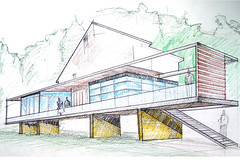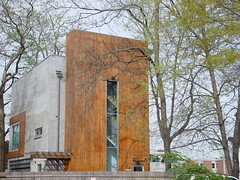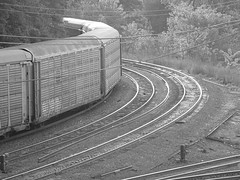Saturday, April 30, 2005
Friday, April 29, 2005
Thursday, April 28, 2005
PhD Excerpt
I recently completed my doctoral study in Birmingham, United Kingdom. To receive a PhD at the Polytechnic you have to prove that you are creating new knowledge. That sounds easier than it is. It took six years. Here is the introduction for your reading enjoyment.
This study discusses a historical precedent at the Bauhaus in order to set groundwork for the case studies to follow. This particular DBS was carried out by Johannes Itten and Josef Albers and overseen by Bauhaus founder Walter Gropius. As these faculty emigrated to the United States during World War II, they led major schools of architecture in the United States. Josef Albers taught at Yale University, one of the detailed case studies discussed later in the research. The implication is that the Bauhaus became a paradigmatic example for North American schools of architecture and that the DBS owes a debt to the originators of the Sommerfield House DBS.
The two American case studies chosen reveal many student comments and discuss the student and faculty objectives. In the Yale University example, the reader will see a professor who has focused the class efforts on one neighbourhood in New Haven, Connecticut. The projects are usually conceived without direct input from the end user. Students who enter the studio appear to have very different skill sets and quotes, such as “I transferred to Yale because of the Building Project. I have an art degree and when I was put up against these students to design a house in five weeks--these students who had Architecture Degrees and had worked in offices--it was intimidating and they won the design competition. I felt out of place.” This will reveal a weakness in the Yale system and suggest possible improvements in the studio and the learning outcomes. These improvements could include a more collaborative--and less competitive--design selection process and the inclusion of end user clients in the early part of the design process.
Auburn University’s Rural Studio was chosen to contrast with the Yale programme, which is the oldest DBS in North America. The research reveals the strong and relevant contribution this studio has brought to the poorest county in Alabama, as well as the strong collaborative process and clear vision of the studio’s founders, Professors D.K. Ruth and Samuel Mockbee. Through in-depth interviews with students and faculty, the researcher reveals that this DBS provides a valid model that is transferable to most contexts. Student Adam Gerndt describes the idea of community immersion: “The project taught me a lot about listening. First we worked alongside the community members, cutting weeds and repairing houses. We wanted to do a community project so we felt that this way we could identify what the community wanted. That is how we gained their trust and respect. We identified the chapel as the project and worked hard to complete it. My major critique of the Rural Studio is that the project either needs more time or we need to simplify the type of project because we had to work all summer--past graduation--to complete the work. The same thing happened to some of my classmates. We all worked really hard all summer, while our classmates all graduated months before” (Gerndt, 2003).
The concluding chapter conceptually enriches the study by examining the implications of cutting-edge practice-based techniques. A major critique of the cited DBS projects is that they use technologies that are, for the most part, outdated. Beyond even the boundary of this study, the DBS is generally relegated to outdated technologies, such as balloon frame wood construction. This chapter discusses these new technologies, such as CATIA modelling, automated construction, innovative materials and full-scale detail study.
The overall intent of the study is to reveal the relevance and possible significance of the DBS as a type of learning. As with any new educational paradigm, there are inherent weaknesses in the early prototypes. This study attempts to identify some of these weaknesses in order to allow the DBS programmes to refine and enhance themselves through intense and rigorous research and development.
Careful research revealed that very little literature on the subject exists, and despite much anguish in the search, conventional means for analysing design studios could not be used. The thesis more accurately considers the case studies and presents a model for consideration as a new paradigm. The case studies and data used were chosen with discernment. They are not a priori and therefore do not attempt to collect information that contains preconceived theories about DBS. The study is structured in a way to best present the information and findings and best present how the information was told, as a story, to the researcher.
Throughout the history of architecture, buildings have been created through the transformation of ideas into physical structures. Today, the practice has been segmented into the architects’ work in designing and preparing documents to build with, and the contractors’ work, which involves actually constructing the architect’s design. These are distinct and separate acts.
This research explores the use of materials such as concrete, wood, glass and steel, and demonstrates how students’ learning can potentially be enhanced when exposed to these real materials in a tactile sense. The study of the nature of the design process has long been of interest to architectural theorists, and some of these theorists have taken a strong interest in construction as an important canon of architectural process (Broadbent, 1988; Nesbitt, 1996). This study concentrates on how the design-build studio (described as DBS for the purpose of this study) is being used in architectural education as a new model, enriching the learning process of the architect (Boyer and Mitgang, 1996).
This study outlines the overall changes, which have brought about new trends in design education. As architectural practice moves toward systems integration and a closer link to the construction of buildings, the presentation of the collaborative process in architectural education is vital. It is clear that DBS must be integrally connected to the curricula and studio sequence of architectural programmes.
Finally, the study describes the development of traditional and progressive attitudes toward design education, arguing that changes are needed in educational philosophy in order to improve the training of the architect. The central aim of this research is to examine the DBS as an educational model.
Overview of the DBS
Design education models, which are most influenced by the French Ecole des Beaux Arts and the German Bauhaus, pervade the U.S architectural education system. Each university in the United States seems to have its own hybrid of these two paradigms. The Ecole des Beaux Arts centred architectural learning on historical precedent and a linear process of design. The Bauhaus was diametrically opposed to the Ecole des Beaux Arts and fostered a cyclical and fluid design process and a forward thinking pedagogy that was engaged with industry and mass production. Many of the Bauhaus professors migrated to the U.S. after World War II and the closing of the Bauhaus by Adolf Hitler and the Nazi government in 1933. Former Bauhaus directors Mies van der Rohe and Walter Gropius led major architectural programmes at Illinois Institute of Technology and at the Harvard Graduate School of Design, respectively. The Bauhaus pedagogy specifically aimed to connect the craftsman with the artist. It also put building at the centre of the architect’s training. Most of these programmes are a unique hybrid of Beaux Arts and Bauhaus methodologies based on the training and influences of their faculties.
The master builders of cathedrals such as Chartres, St. Paul’s and Amiens worked on the design and construction supervision simultaneously, with a direct connection between the designer and the craftsmen. The act of design and making were seamlessly linked (Frampton, 1996). At the Brion-Vega Cemetery in Treviso, Italy, workmen were directly involved in the design process by the forward-thinking artist and architect Carlo Scarpa. Scarpa clearly understood the value of directly involving the maker in the design process. He described this benefit as an integral part of his own work and understood how to integrate these craftspeople directly into the process (Frampton, 1996). Antonio Gaudi at his Church of La Sagrada Familia in Barcelona used the same practice. Here Gaudi asked workmen to contribute to architectural ideas during construction. Today, such levels of craft skill are rare, making the architect’s knowledge more imperative.
The hypothetico-deductive method, such as those used by Easterby-Smith and McCabe, helped to underscore these concerns and helped the researcher see that he was not alone in this vast sea of shallow thinking and dead ends. “The disadvantages (of hypothesis testing) are that its contribution may be quite trivial, (simply) confirming what is already known. And if the results are inconclusive or negative, the approach can give little guidance on why this is so” (Easterby-Smith, 1994). And McCabe states, “Theory--if it has any role at all--need be considered only subsequent to the collection of data” (1999).
To this end, the researcher cut the study into one quarter of its original focus, which revealed an entire new world--that of detail and analysis. Consistent with the principle of interpretivisim, the researcher revisited the schools. The original visit was too shallow and did not reveal the negative aspects. This was a difficult challenge as funds had grown spare and energy was flagging.
Most important was the conclusion that the Bauhaus' “learning-by-doing” workshop and studio had to be studied, as it provides consistent definable and indefinable intellectual and pedagogical threads that intertwine their way through this study and each of the DBS programmes. Further, Albers making his way to Yale University and the direct influence on students and faculty is undeniable. More unclear is Albers' influence on the other architectural programmes that integrate the DBS method. But questions kept emerging in the researchers mind: Is this whole study worthless? Is it too subjective? Perhaps this pessimism is necessary for any successful critical analysis. The empirical data presented in the latter chapters reveals that the DBS programmes have bold intentions for the architectural programmes and for learning outcomes. Interestingly, the learning outcomes can only be deduced by inference through on-site and post-experience interviews with the students and clients; grades and assessment prove difficult and subjective.
The researcher learned from numerous visits, interviews and publications that the DBS professors had a common objective that resonated in their learning objectives: learning by doing.
The Aims and Boundaries of this Study
AIM ONE
To analyse two selected case studies of Design and Build approaches within North American universities to identify intended learning goals and outcomes specific to these studies in relationship to the wider curricula.
AIM TWO
To determine the extent to which live projects within architectural studios can provide successful simulations of design and build delivery methods, including technology, craftsmanship and design.
Boundaries
Specifically, the study examines one historical prototype: the Itten/Albers “learning-by-doing” workshop of 1922-27 at Weimar, Germany, which was offered at the height of the Bauhaus teaching. Two other significant DBS prototypes have been selected: the Auburn University Rural Studio and the Yale University Building Project. For the boundary of this study these were chosen for their rigorous design intentions and professors' clear course objectives. One model is rural in focus and the other is urban/suburban. One case study is based upon student collaboration to achieve a final design scheme, the other on a competitive structure. Theory testing data was carried out through interviews and on site data collection. Some of the interviews were unstructured, while others involved a more structured format.
1.5 Hypothesis
Within the DBS exists a compelling interaction between the emergent design concept and the project team. Unlike the insular esquisse predecessor, the concept in the DBS is alive and changing with the existent dynamic forces, which are exerted. While it emulates the flux and problems of real life experiences, it simultaneously presents a compelling array of concurrent scales and enhanced decision-based thinking. Students learn to cope with crises non-sequentially and are more prepared to deal with practice.
Since the Renaissance, architects have been identified as performing a distinctly different range of tasks separating them from the actual on-site construction processes. Architecture became an expression of upper-middle-class culture, and architects themselves were elevated into this class of society. This separation also exists within architectural education, and this has recently been recognized by many educators as being something that should be addressed through syllabus design.
At the German Bauhaus at Dessau, Walter Gropius suggested that this separation of craftsman and artisan must be addressed (Wick, 2000). To deal with this schism, Bauhaus faculty members Johannes Itten and Josef Albers authored a learning-by-doing studio. The Bauhaus had an indelible effect on North American architectural education, perhaps in part due to Josef Albers' transfer to Yale University, a site of one of the case studies in this research.
In many American schools of architecture, the design-build studio (Boyer, 1997)(Carpenter, 1997) is the preferred vehicle chosen to respond to this need. This thesis will examine such studio programmes and evaluate their contribution to the pedagogy of curriculum development. The DBS faculty hypothesize that the design-build studio provides a sufficiently accurate paradigm for this process in real life and that the learning outcomes it produces responds to the complex demands of practice.
This study will examine this hypothesis as manifest in several selected examples, and to evaluate them together with evolving educational theories and practice developments, with a view to assessing whether or not they are achieving their objectives and how they relate to the design-build movement overall. It will also examine the evolution of these studios and their response to a rapidly changing world in which technology transfer, virtual reality, sustainability and the like are setting new criteria of performance demands.
Currently in North American architectural education, the DBS has emerged as a developing philosophy. The movement may or may not be creating a watershed change. This study will examine and analyse the learning opportunities for students in the DBS.
This study discusses a historical precedent at the Bauhaus in order to set groundwork for the case studies to follow. This particular DBS was carried out by Johannes Itten and Josef Albers and overseen by Bauhaus founder Walter Gropius. As these faculty emigrated to the United States during World War II, they led major schools of architecture in the United States. Josef Albers taught at Yale University, one of the detailed case studies discussed later in the research. The implication is that the Bauhaus became a paradigmatic example for North American schools of architecture and that the DBS owes a debt to the originators of the Sommerfield House DBS.
The two American case studies chosen reveal many student comments and discuss the student and faculty objectives. In the Yale University example, the reader will see a professor who has focused the class efforts on one neighbourhood in New Haven, Connecticut. The projects are usually conceived without direct input from the end user. Students who enter the studio appear to have very different skill sets and quotes, such as “I transferred to Yale because of the Building Project. I have an art degree and when I was put up against these students to design a house in five weeks--these students who had Architecture Degrees and had worked in offices--it was intimidating and they won the design competition. I felt out of place.” This will reveal a weakness in the Yale system and suggest possible improvements in the studio and the learning outcomes. These improvements could include a more collaborative--and less competitive--design selection process and the inclusion of end user clients in the early part of the design process.
Auburn University’s Rural Studio was chosen to contrast with the Yale programme, which is the oldest DBS in North America. The research reveals the strong and relevant contribution this studio has brought to the poorest county in Alabama, as well as the strong collaborative process and clear vision of the studio’s founders, Professors D.K. Ruth and Samuel Mockbee. Through in-depth interviews with students and faculty, the researcher reveals that this DBS provides a valid model that is transferable to most contexts. Student Adam Gerndt describes the idea of community immersion: “The project taught me a lot about listening. First we worked alongside the community members, cutting weeds and repairing houses. We wanted to do a community project so we felt that this way we could identify what the community wanted. That is how we gained their trust and respect. We identified the chapel as the project and worked hard to complete it. My major critique of the Rural Studio is that the project either needs more time or we need to simplify the type of project because we had to work all summer--past graduation--to complete the work. The same thing happened to some of my classmates. We all worked really hard all summer, while our classmates all graduated months before” (Gerndt, 2003).
The concluding chapter conceptually enriches the study by examining the implications of cutting-edge practice-based techniques. A major critique of the cited DBS projects is that they use technologies that are, for the most part, outdated. Beyond even the boundary of this study, the DBS is generally relegated to outdated technologies, such as balloon frame wood construction. This chapter discusses these new technologies, such as CATIA modelling, automated construction, innovative materials and full-scale detail study.
The overall intent of the study is to reveal the relevance and possible significance of the DBS as a type of learning. As with any new educational paradigm, there are inherent weaknesses in the early prototypes. This study attempts to identify some of these weaknesses in order to allow the DBS programmes to refine and enhance themselves through intense and rigorous research and development.
Careful research revealed that very little literature on the subject exists, and despite much anguish in the search, conventional means for analysing design studios could not be used. The thesis more accurately considers the case studies and presents a model for consideration as a new paradigm. The case studies and data used were chosen with discernment. They are not a priori and therefore do not attempt to collect information that contains preconceived theories about DBS. The study is structured in a way to best present the information and findings and best present how the information was told, as a story, to the researcher.
Throughout the history of architecture, buildings have been created through the transformation of ideas into physical structures. Today, the practice has been segmented into the architects’ work in designing and preparing documents to build with, and the contractors’ work, which involves actually constructing the architect’s design. These are distinct and separate acts.
This research explores the use of materials such as concrete, wood, glass and steel, and demonstrates how students’ learning can potentially be enhanced when exposed to these real materials in a tactile sense. The study of the nature of the design process has long been of interest to architectural theorists, and some of these theorists have taken a strong interest in construction as an important canon of architectural process (Broadbent, 1988; Nesbitt, 1996). This study concentrates on how the design-build studio (described as DBS for the purpose of this study) is being used in architectural education as a new model, enriching the learning process of the architect (Boyer and Mitgang, 1996).
This study outlines the overall changes, which have brought about new trends in design education. As architectural practice moves toward systems integration and a closer link to the construction of buildings, the presentation of the collaborative process in architectural education is vital. It is clear that DBS must be integrally connected to the curricula and studio sequence of architectural programmes.
Finally, the study describes the development of traditional and progressive attitudes toward design education, arguing that changes are needed in educational philosophy in order to improve the training of the architect. The central aim of this research is to examine the DBS as an educational model.
Overview of the DBS
Design education models, which are most influenced by the French Ecole des Beaux Arts and the German Bauhaus, pervade the U.S architectural education system. Each university in the United States seems to have its own hybrid of these two paradigms. The Ecole des Beaux Arts centred architectural learning on historical precedent and a linear process of design. The Bauhaus was diametrically opposed to the Ecole des Beaux Arts and fostered a cyclical and fluid design process and a forward thinking pedagogy that was engaged with industry and mass production. Many of the Bauhaus professors migrated to the U.S. after World War II and the closing of the Bauhaus by Adolf Hitler and the Nazi government in 1933. Former Bauhaus directors Mies van der Rohe and Walter Gropius led major architectural programmes at Illinois Institute of Technology and at the Harvard Graduate School of Design, respectively. The Bauhaus pedagogy specifically aimed to connect the craftsman with the artist. It also put building at the centre of the architect’s training. Most of these programmes are a unique hybrid of Beaux Arts and Bauhaus methodologies based on the training and influences of their faculties.
The master builders of cathedrals such as Chartres, St. Paul’s and Amiens worked on the design and construction supervision simultaneously, with a direct connection between the designer and the craftsmen. The act of design and making were seamlessly linked (Frampton, 1996). At the Brion-Vega Cemetery in Treviso, Italy, workmen were directly involved in the design process by the forward-thinking artist and architect Carlo Scarpa. Scarpa clearly understood the value of directly involving the maker in the design process. He described this benefit as an integral part of his own work and understood how to integrate these craftspeople directly into the process (Frampton, 1996). Antonio Gaudi at his Church of La Sagrada Familia in Barcelona used the same practice. Here Gaudi asked workmen to contribute to architectural ideas during construction. Today, such levels of craft skill are rare, making the architect’s knowledge more imperative.
The hypothetico-deductive method, such as those used by Easterby-Smith and McCabe, helped to underscore these concerns and helped the researcher see that he was not alone in this vast sea of shallow thinking and dead ends. “The disadvantages (of hypothesis testing) are that its contribution may be quite trivial, (simply) confirming what is already known. And if the results are inconclusive or negative, the approach can give little guidance on why this is so” (Easterby-Smith, 1994). And McCabe states, “Theory--if it has any role at all--need be considered only subsequent to the collection of data” (1999).
To this end, the researcher cut the study into one quarter of its original focus, which revealed an entire new world--that of detail and analysis. Consistent with the principle of interpretivisim, the researcher revisited the schools. The original visit was too shallow and did not reveal the negative aspects. This was a difficult challenge as funds had grown spare and energy was flagging.
Most important was the conclusion that the Bauhaus' “learning-by-doing” workshop and studio had to be studied, as it provides consistent definable and indefinable intellectual and pedagogical threads that intertwine their way through this study and each of the DBS programmes. Further, Albers making his way to Yale University and the direct influence on students and faculty is undeniable. More unclear is Albers' influence on the other architectural programmes that integrate the DBS method. But questions kept emerging in the researchers mind: Is this whole study worthless? Is it too subjective? Perhaps this pessimism is necessary for any successful critical analysis. The empirical data presented in the latter chapters reveals that the DBS programmes have bold intentions for the architectural programmes and for learning outcomes. Interestingly, the learning outcomes can only be deduced by inference through on-site and post-experience interviews with the students and clients; grades and assessment prove difficult and subjective.
The researcher learned from numerous visits, interviews and publications that the DBS professors had a common objective that resonated in their learning objectives: learning by doing.
The Aims and Boundaries of this Study
AIM ONE
To analyse two selected case studies of Design and Build approaches within North American universities to identify intended learning goals and outcomes specific to these studies in relationship to the wider curricula.
AIM TWO
To determine the extent to which live projects within architectural studios can provide successful simulations of design and build delivery methods, including technology, craftsmanship and design.
Boundaries
Specifically, the study examines one historical prototype: the Itten/Albers “learning-by-doing” workshop of 1922-27 at Weimar, Germany, which was offered at the height of the Bauhaus teaching. Two other significant DBS prototypes have been selected: the Auburn University Rural Studio and the Yale University Building Project. For the boundary of this study these were chosen for their rigorous design intentions and professors' clear course objectives. One model is rural in focus and the other is urban/suburban. One case study is based upon student collaboration to achieve a final design scheme, the other on a competitive structure. Theory testing data was carried out through interviews and on site data collection. Some of the interviews were unstructured, while others involved a more structured format.
1.5 Hypothesis
Within the DBS exists a compelling interaction between the emergent design concept and the project team. Unlike the insular esquisse predecessor, the concept in the DBS is alive and changing with the existent dynamic forces, which are exerted. While it emulates the flux and problems of real life experiences, it simultaneously presents a compelling array of concurrent scales and enhanced decision-based thinking. Students learn to cope with crises non-sequentially and are more prepared to deal with practice.
Since the Renaissance, architects have been identified as performing a distinctly different range of tasks separating them from the actual on-site construction processes. Architecture became an expression of upper-middle-class culture, and architects themselves were elevated into this class of society. This separation also exists within architectural education, and this has recently been recognized by many educators as being something that should be addressed through syllabus design.
At the German Bauhaus at Dessau, Walter Gropius suggested that this separation of craftsman and artisan must be addressed (Wick, 2000). To deal with this schism, Bauhaus faculty members Johannes Itten and Josef Albers authored a learning-by-doing studio. The Bauhaus had an indelible effect on North American architectural education, perhaps in part due to Josef Albers' transfer to Yale University, a site of one of the case studies in this research.
In many American schools of architecture, the design-build studio (Boyer, 1997)(Carpenter, 1997) is the preferred vehicle chosen to respond to this need. This thesis will examine such studio programmes and evaluate their contribution to the pedagogy of curriculum development. The DBS faculty hypothesize that the design-build studio provides a sufficiently accurate paradigm for this process in real life and that the learning outcomes it produces responds to the complex demands of practice.
This study will examine this hypothesis as manifest in several selected examples, and to evaluate them together with evolving educational theories and practice developments, with a view to assessing whether or not they are achieving their objectives and how they relate to the design-build movement overall. It will also examine the evolution of these studios and their response to a rapidly changing world in which technology transfer, virtual reality, sustainability and the like are setting new criteria of performance demands.
Currently in North American architectural education, the DBS has emerged as a developing philosophy. The movement may or may not be creating a watershed change. This study will examine and analyse the learning opportunities for students in the DBS.
holguinzimmer

holguinzimmer
Originally uploaded by lightroomstudio.
Kevin and I drew this project over a year ago; now it is coming up out of the ground and some progress pictures will follow soon.
Pink Purse

Pink Purse
Originally uploaded by lightroomstudio.
Sometimes you are in the right place at the right time.
Wednesday, April 27, 2005
The Captain

DSC05268
Originally uploaded by lightroomstudio.
Whe I met him he stared at me for over ten minutes. Then he smiled and said something I did not understand.
Esme in the Spring

DSC04616
Originally uploaded by lightroomstudio.
There are times when Esme looks like Audrey Hepburn and other times when she just looks like Esme.
Architectural Record Book Review
I was recently asked to write a book review, here it is.
Designing for the Homeless; Architecture that Works, by Sam Davis. Berkeley: The University of California Press, 2004, 176 pages, $34.95 (cloth)
This important new book is first of all a call to action for architects. Sam Davis, a UC Berkeley professor and architect of affordable housing, presents homelessness as a complex problem that architects can and should help ameliorate. Robert Gutman rightly says in a blurb for the book, “The subject of homelessness has often been discussed, but no one before has cut such a broad swath through the subject,”
Davis’ approach ranges beyond design and planning to the societal costs of homelessness and the personal concerns of the afflicted. He tells how unforeseen events can catapult a once-ordinary person into living on the streets and argues that a continuum of housing types is needed--from emergency shelters through assisted-living to independence. Needed too, he writes is a continuum of services, social, psychological, educational, employment-oriented, financial, When it comes to design, he discusses the challenges of fitting projects into existing communities and compares various plans and interior layouts, asking such questions as how should the housing look and how should it feel. He evaluates costs and expenditures and writes: “Some architects maintain that the best way to achieve affordable housing is to recognize cost limitations at the outset and make compromises on space standards, amenities, and even quality; others argue, as I have, that affordable housing should be indistinguishable from nearby housing so that residents will not feel stigmatized and will feel a part of the surrounding community”
The author focuses on case studies, including the St. Vincent de Paul Village in San Diego (1987), a center that offers customized care, helping people earn GEDs, train on computers, find jobs, receive medical and dental care, and take charge of their own lives. In New York, he cites the Family Transitional Shelter and the First Step Housing project. In San Francisco, he mentions Donald MacDonald’s City Sleepers, four-foot-high, 32-square foot sleeping units that are constructed of plywood, are waterproof, have a sliding glass window and screen, and stand 18 inches off the ground on inverted car jacks. Also in San Francisco, Davis writes about a small structure modeled on temporary housing for victims of the 1906 earthquake, the work of Jim Reid, a former contractor, homebuilder, and mayoral candidate. Reid says the 100-square-foot structure, including laundry facilities and a full bath, proves how easy it is to house San Francisco's homeless. In Atlanta, Davis cites the work of the Mad Housers, a nonprofit that helps provide housing for the homeless.
Davis notes that in Atlanta alone there are over 10,000 homeless people at peak times and less than 1,000 beds available, and that architects and architecture students can and should help provide homes to those living on the streets. That message is Sam Davis major theme and contribution. The illustrations in Designing for the Homeless’ aren’t of the best quality and Davis hasn’t brought the facts of homelessness up to date. More important, however, is that he has given us a significant book; it packs a considerable punch in a scant 145 pages. William J. Carpenter
Designing for the Homeless; Architecture that Works, by Sam Davis. Berkeley: The University of California Press, 2004, 176 pages, $34.95 (cloth)
This important new book is first of all a call to action for architects. Sam Davis, a UC Berkeley professor and architect of affordable housing, presents homelessness as a complex problem that architects can and should help ameliorate. Robert Gutman rightly says in a blurb for the book, “The subject of homelessness has often been discussed, but no one before has cut such a broad swath through the subject,”
Davis’ approach ranges beyond design and planning to the societal costs of homelessness and the personal concerns of the afflicted. He tells how unforeseen events can catapult a once-ordinary person into living on the streets and argues that a continuum of housing types is needed--from emergency shelters through assisted-living to independence. Needed too, he writes is a continuum of services, social, psychological, educational, employment-oriented, financial, When it comes to design, he discusses the challenges of fitting projects into existing communities and compares various plans and interior layouts, asking such questions as how should the housing look and how should it feel. He evaluates costs and expenditures and writes: “Some architects maintain that the best way to achieve affordable housing is to recognize cost limitations at the outset and make compromises on space standards, amenities, and even quality; others argue, as I have, that affordable housing should be indistinguishable from nearby housing so that residents will not feel stigmatized and will feel a part of the surrounding community”
The author focuses on case studies, including the St. Vincent de Paul Village in San Diego (1987), a center that offers customized care, helping people earn GEDs, train on computers, find jobs, receive medical and dental care, and take charge of their own lives. In New York, he cites the Family Transitional Shelter and the First Step Housing project. In San Francisco, he mentions Donald MacDonald’s City Sleepers, four-foot-high, 32-square foot sleeping units that are constructed of plywood, are waterproof, have a sliding glass window and screen, and stand 18 inches off the ground on inverted car jacks. Also in San Francisco, Davis writes about a small structure modeled on temporary housing for victims of the 1906 earthquake, the work of Jim Reid, a former contractor, homebuilder, and mayoral candidate. Reid says the 100-square-foot structure, including laundry facilities and a full bath, proves how easy it is to house San Francisco's homeless. In Atlanta, Davis cites the work of the Mad Housers, a nonprofit that helps provide housing for the homeless.
Davis notes that in Atlanta alone there are over 10,000 homeless people at peak times and less than 1,000 beds available, and that architects and architecture students can and should help provide homes to those living on the streets. That message is Sam Davis major theme and contribution. The illustrations in Designing for the Homeless’ aren’t of the best quality and Davis hasn’t brought the facts of homelessness up to date. More important, however, is that he has given us a significant book; it packs a considerable punch in a scant 145 pages. William J. Carpenter
Subscribe to:
Posts (Atom)





